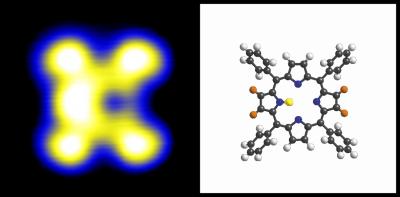The smallest nanoswitch
December 13, 2011

Nanoscale switch based on a single porphyrin ring. If one of two protons from the inside of the ring is removed, the remaining proton can take on any one of four positions, initiated by a single tunnel electron from the tip of a scanning tunneling microscope. (Credit: Knud Seufert/Technische Universitaet Muenchen)
Technische Universitaet Muenchen (TUM) researchers have developed a novel molecular switch that uses the position of a single proton in a porphyrin ring to set four distinct states on demand at 500 times per second.
They removed one of the two protons from the inside of the porphyrin ring. The remaining proton could now take on any one of four positions. A tiny current that flows through the fine tip of a scanning tunneling microscope stimulates the proton transfer, setting a specific configuration in the process. The molecular switch has a surface area of only one square nanometer, making it the smallest switch implemented to date.
Ref.: Willi Auwaerter, et al., A surface-anchored molecular four-level conductance switch based on single proton transfer, Nature Nanotechnology, Advance Online Publication, 11 December 2011; [DOI:10.1038/nnano.2011.211]